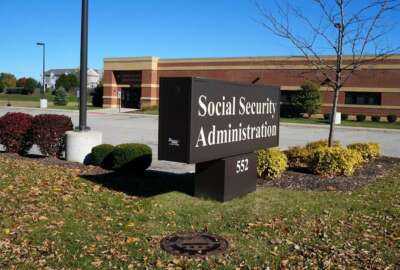SSA union, managers push back on leadership’s ‘business as usual’ office reentry plan
Officials say SSA leadership isn’t giving much ground on key elements of office reentry, such as telework, or initially opening SSA field offices on an...
The Social Security Administration struck a recent deal with its unions to return employees to the office by the end of March.
Both parties are in talks to negotiate the finer points of that office reentry, but officials say SSA leadership isn’t giving much ground on key elements such as telework, or initially opening SSA field offices on an appointment-only basis.
The American Federation of Government Employees Local Council 220, which represents about 23,000 SSA employees, said agency leadership is pursuing a “ business as usual” reentry plan that would fully reopen field offices to walk-in service.
Angela Digeronimo, vice president of AFGE Local Council 220, said that SSA’s office reentry plan raises health and safety concerns, and would make the agency’s workforce less productive than its current telework posture, or a hybrid between telework and in-office work.
Digeronimo said the union held its first meeting with SSA’s Deputy Commissioner of Operations Grace Kim on Jan. 31, but the meeting didn’t address the union’s top health and safety concerns with office reentry.
“We weren’t really discussing meat-and-potato issues. What we want to talk about is health and safety, how are people going to go back into the offices and be safe, and also keep the public safe, especially in the field offices,” Digeronimo said in an interview.
SSA press officer Mark Hinkle told Federal News Network that, “dependent on the course of the pandemic,” the agency will continue with its reentry and the implementation of new telework schedules for most employees on March 30.
“This date allows us to ensure that the necessary measures are in place to keep our employees and the public safe, is consistent with our union agreements, and has given us time to provide notice to our employees,” Hinkle said.
Hinkle said SSA anticipates local field offices will restore increased in-person service to the public, without an appointment, in early April.
“As we expand in-person availability, we strongly encourage the public to continue to go online, call us for help if they cannot complete their business online, and schedule appointments in advance. Customers who walk in without appointments may encounter delays,” Hinkle said.
A “reentry checklist” obtained by Federal News Network directs front-line supervisors to collect telework requests from employees by Feb. 25. SSA expects supervisors to decide on those telework requests by March 8.
The checklist also allows office managers, starting March 9, to begin adjudicating telework temporary compassionate allowances, and telework reasonable accommodation requests.
Digeronimo said the union is seeking clarification on how employees working in teleservice centers will socially distance themselves from coworkers once they all return to the office, and whether they will need to wear masks all day while answering phone calls.
AFGE Council 220 is also requesting SSA field offices initially open on an appointment-only basis, to prevent overcrowding and protect the elderly and disabled population that SSA serves.
SSA field offices have been mostly closed to the public, or open by appointment for “dire-needs” only, since March 2020.
“We recognize the doors need to be open, but we are putting forward some progressive ideas to leverage technology so that we give the public a multitude of ways to contact us and to conduct business with us. But the agency is not willing to listen. They are antiquated in their thinking, and it is just easier for them to just go back to business as usual, which in our mind, is not safe,” Digeronimo said.
As part of their office reentry agreement, SSA and AFGE agreed to hold several meetings over component-level reentry and workplace safety.
Within seven days of the final reentry meeting, which is planned for early March, the memo states AFGE may submit a bargaining request to address “unresolved issues.”
AFGE said the March 30 return date is subject to changes in pandemic conditions and these negotiations with agency components.
Despite that contingency, Digeronimo said Kim held a recent meeting with agency managers and supervisors, and said the agency would reopen field offices on March 30, regardless of how component-level negotiations go.
“She made it seem like a done deal. This was a hard, fast, we are reentering on March 30,” Digeronimo said.
SSA managers, meanwhile, share many of the same concerns about office reentry. An email compiling comments from SSA managers to agency leadership shows front-line managers and supervisors are frustrated that the agency has not considered feedback from managers in office reopening.
“This was an opportunity to change how we do business, to use technology and give the public the ability to schedule appointments via an app or our website. We have a responsibility to the public to keep them safe and the agency should also keep management and our employees safe,” one manager wrote to SSA leadership.
Another manager raised concerns about waiting times in field offices, “considering we will have large crowds coming into the office with minimal staff to serve them.”
“Our response to the pandemic has proven the effectiveness and efficiency of an appointment-only business model. What is the business rationale for returning to walk-in traffic? The expectations the agency is placing on management to manage walk-in traffic, in addition to everything we already do and will need to do, is not realistic. This additional responsibility is one that is not possible,” the manager wrote.
Managers are also asking whether they will have to screen visitors to ensure compliance with mask-wearing requirements, or whether they will have the discretion to limit service to the public, once a field office has reached its capacity for the day.
“Given the potential reaction from the public if we do have to turn people away, who will be responsible for this type of action? [Who] will ensure management is safe?” the manager wrote.
Management also expressed disappointment with only now being brought into reentry conversations with SSA leadership, after the agency already signed memorandums of understanding with its unions.
“The fact that we are not hearing from agency leadership at this point after a reentry date has been announced speaks volumes about their disregard and disrespect for field management. Management morale has never been so low. We feel belittled and abused. No other words can describe what the agency has done to management ranks,” another manager wrote.
Managers and supervisors urged SSA leadership to allow some workplace flexibility at least through June or September, warning that employees may look for other job opportunities elsewhere in government or in the private sector that have more flexibility and work-from-home options.
“Asking employees to ‘figure it out’ in the middle of a school year is not family-friendly or fair,” one manager wrote.
Digeronimo said SSA employees have already left the agency, or are planning to leave the agency ahead of the March 30 reopening target.
“For the first time, I am experiencing employees resigning. They’re resigning to go to other agencies, some of them that offer telework, that give those flexibilities. I’m experiencing them leaving federal service altogether and going to private industry, where they’re able to get higher wages and also the flexibility of being able to have better hours,” she said.
These departures, Digeronimo said, are adding stress to an already “critically understaffed” workforce. Meanwhile, she said she expects a “very high volume” of employees satisfied with their current telework arrangements to retire from government service, rather than return to the office.
Federal workforce experts have warned about the possibility of a “retirement wave” both before and during the COVID-19 pandemic, but a mass exodus from federal service has yet to materialize.
But if a retirement wave happens within the SSA workforce, Digeronimo said the agency can’t easily maintain its current level of productivity by simply hiring more employees.
“You just can’t hire somebody and expect them to be up to speed in a week or two [or] a month. It usually takes two-to-three years for someone to be fully trained and get comfortable with our programs, our systems, and truly be independent in carrying out their duties,” she said.
Digeronimo said AFGE Council 220 faces the most from the SSA on post-reopening telework, compared to other components, since its members work most directly with the public in field offices.
The agency, she said, “is not even engaging in conversations regarding telework” at this point, but said the union is proposing maximizing telework during the current evaluation period, in order to optimize workforce productivity and service to the public.
“If we maximize telework, then we potentially could quadruple our workforce without having to increase the footprint of the agency, and putting on an added expense of brick-and-mortar buildings. We can rotate people in, have the maximum amount in the office, while we also have people telework and doing tele-claims and doing video claims,” Digeronimo said.
While Digeronimo said it’s “undeniable” that the SSA workforce is more productive at home, she said some employees may prefer to work in the office some or most of the time.
“I don’t want to give the impression that every single employee wants to telework. There are also employees that don’t care if they never telework at another minute in their lives. They’re looking forward to going back into the office and having that experience again. They want to be out in the workforce, and most of them have even volunteered to be those people right now who are in the office and providing service to the public,” she said.
Copyright © 2025 Federal News Network. All rights reserved. This website is not intended for users located within the European Economic Area.
Jory Heckman is a reporter at Federal News Network covering U.S. Postal Service, IRS, big data and technology issues.
Follow @jheckmanWFED






